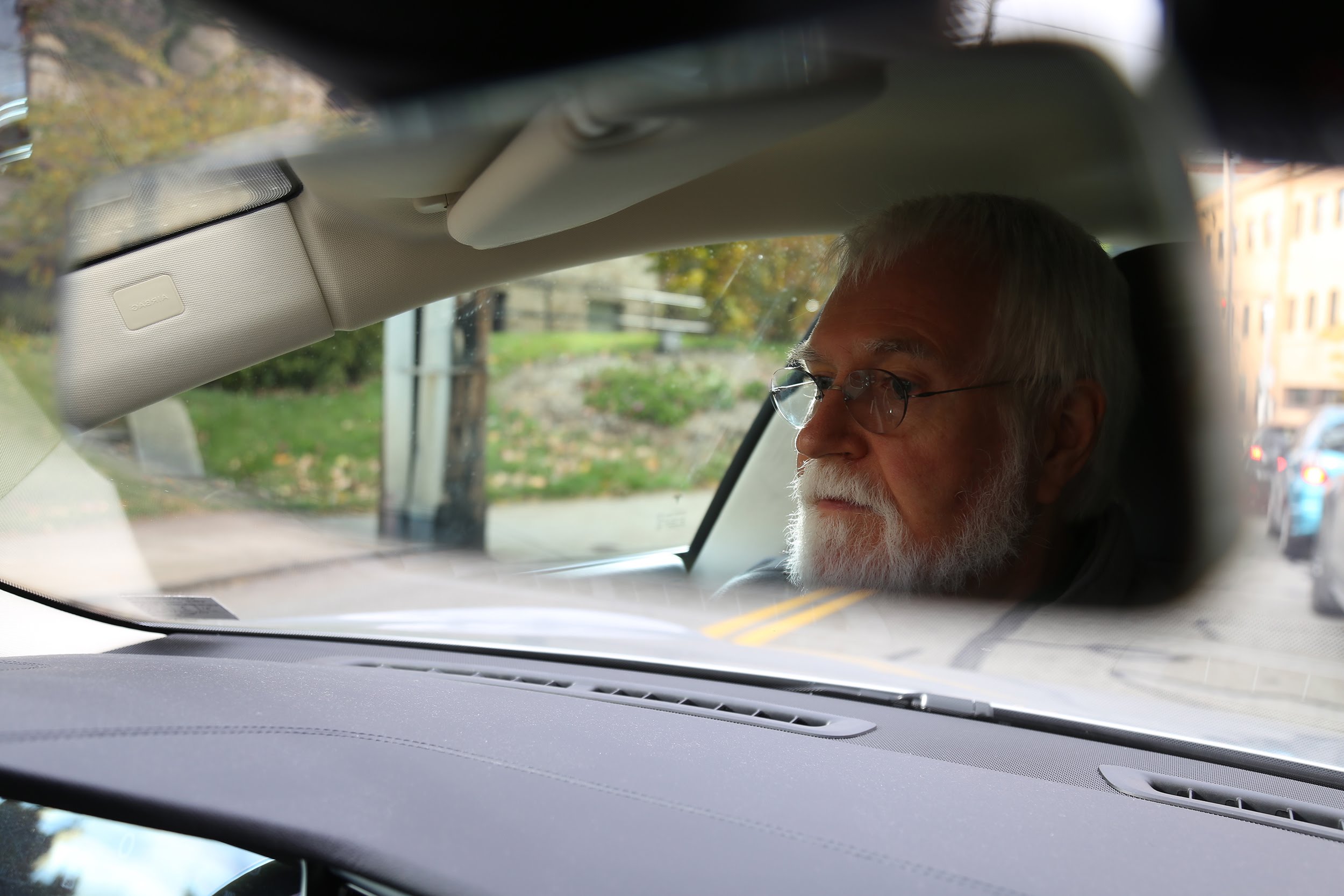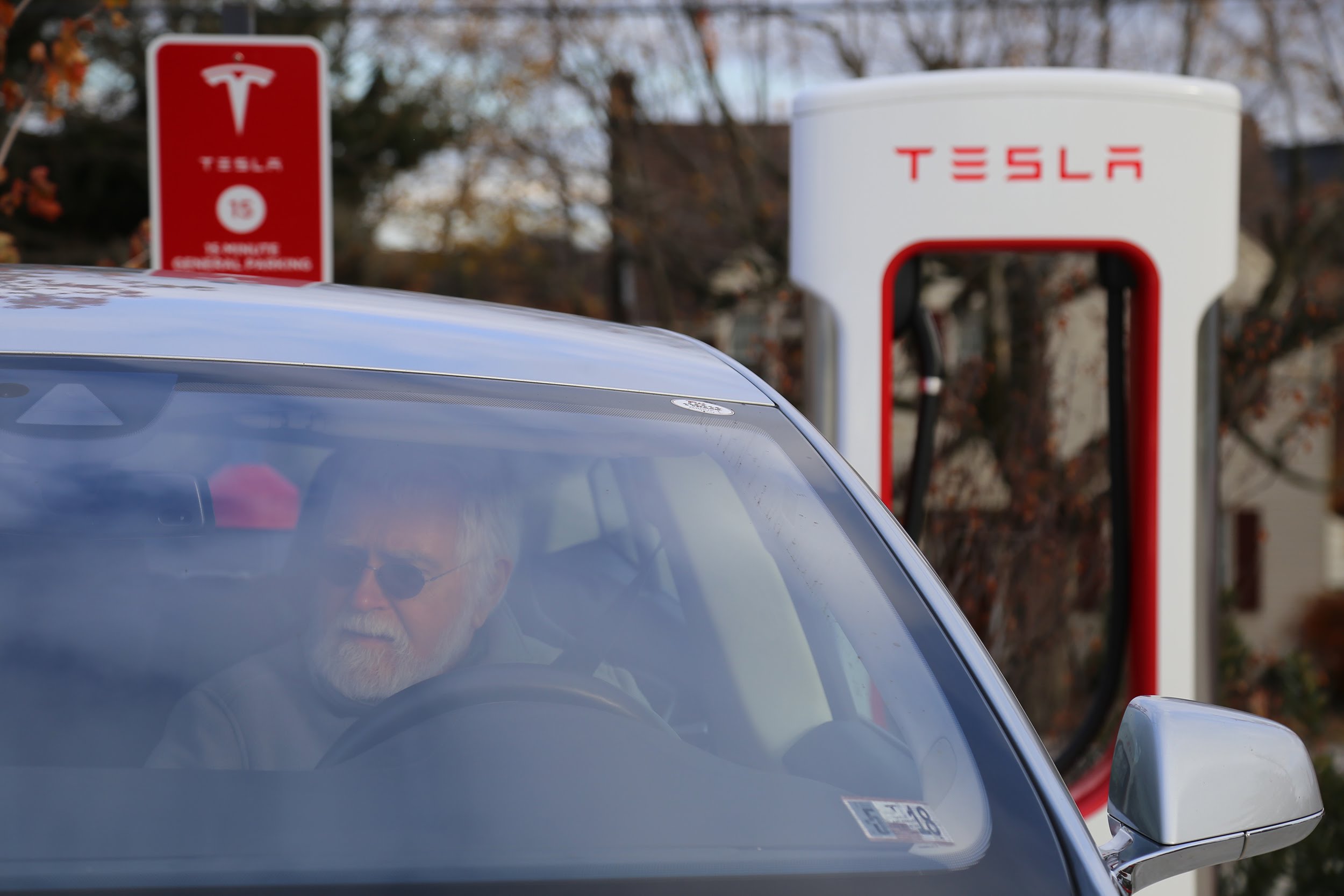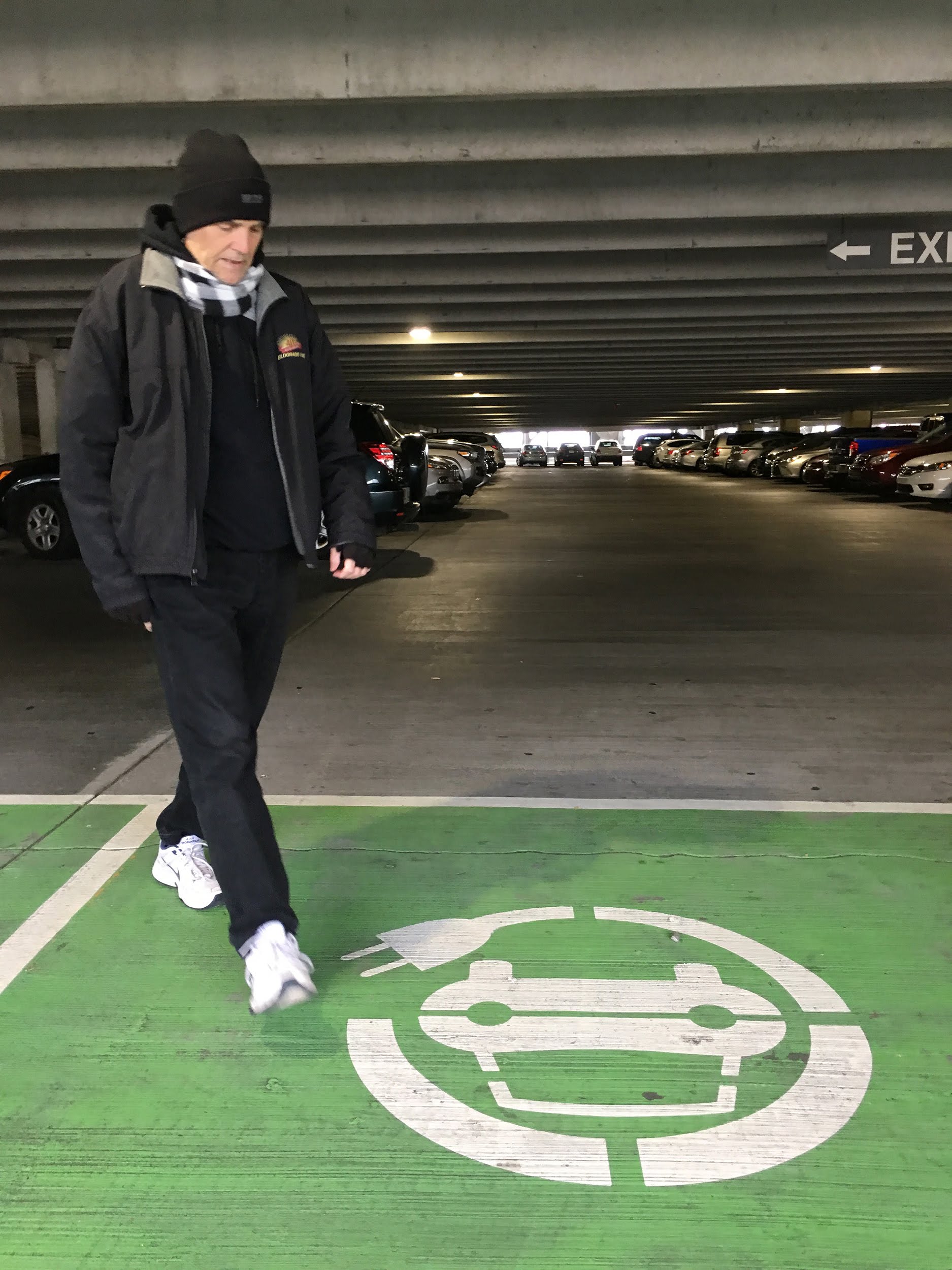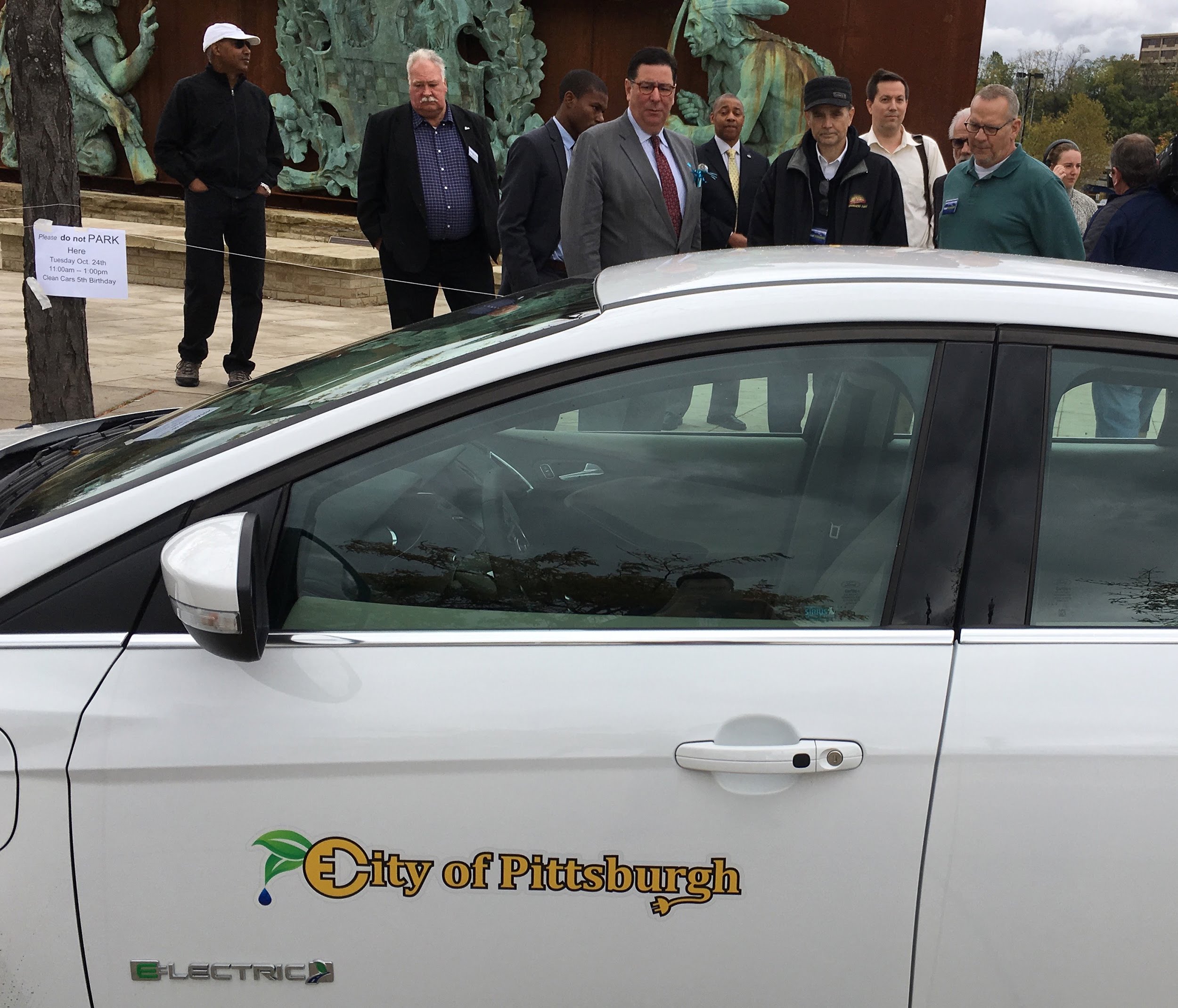
(Photo illustration by Idil Gozde.
Original photo by Ryan Loew/PublicSource)

(Photo illustration by Idil Gozde.
Original photo by Ryan Loew/PublicSource)
As Claus Makowka pulled out of his North Oakland driveway, his Tesla only had 12 percent of its battery charge left.
Our drive was supposed to take 30 minutes. It was a cold day — snowflakes had started to fall as we pulled away. Car batteries don’t keep their charge as well in the cold.
The city of Pittsburgh has made reducing emissions from driving a central part of its plan to tackle climate change. And electrifying the city’s cars is one of its key strategies.
Makowka, who has already driven his Tesla S across the country twice, promised to show me how easy the transition would be. So we set out to test one of Tesla’s new superchargers at a Sheetz gas station.
Makowka calmly pointed to the car’s dashboard screen, which indicated we would arrive with 6 percent to spare, after taking into account the temperature and changes in elevation.


Claus Makowka was ready to drive home after 10 minutes of supercharging at the Sheetz in Franklin Park. Makowka has driven his Tesla across the country and back twice. (Photo by Oliver Morrison/PublicSource)
The instant torque of the car yanked me back against my seat as we pulled away from the first stoplight. Makowka, a retired software designer, said his wife doesn’t like driving his Tesla because of how quickly it accelerates.
In November, Tesla rolled out a new software update called “Chill” to provide “a gentler ride for your passengers.”
“I’m a bit of an evangelist,” Makowka told me, as he smiled and took his hands off the wheel to show off the car’s self-driving features. “To let people know that [an electric car] is not a dramatic change.”
We arrived, like clockwork, with 6 percent of the battery to spare, and then returned back to Pittsburgh less than 10 minutes later, after a brief supercharge left us with enough power to drive another 100 miles.
Makowka's drive really wasn’t any different than if he’d driven in a gas car with only 12 percent of the tank full.
The rise of electric vehicles has been faster than many experts predicted. Although there are only about 650,000 plug-in cars on the road in the United States now, in 2011 there were only about 17,000. About 98 percent are registered in urban areas, according to a 2016 study in the National Bureau of Economic Research.
Transportation is the largest source of emissions in the United States and the second-largest source in Pittsburgh after buildings, at 17 percent of emissions. Most of that is from cars and trucks. If Pittsburgh wants to meet its longer-term goal to reduce emissions 80 percent by 2050, it has to start removing gas and diesel-powered vehicles from the road.
“No one I'm aware of has come up with a carbon neutrality policy that doesn't involve electrification of vehicles eventually,” said Neil Donahue, the director of the Steinbrenner Institute for Environmental Education and Research at Carnegie Mellon.
Owners, like Makowka, are happy with how far their cars travel and how easy they are to recharge. But most other people still have “range anxiety,” a worry that, if they owned an electric car, they would be stranded by an empty battery.
This division between owners and potential owners is one of the defining features of the current electric car market, according to a study this year by McKinsey & Company, one of the country’s leading management consultants.
About 30 percent of car buyers are already thinking about buying an electric car, even though fewer than 2 percent actually did, the McKinsey study found. But more than half the country doesn’t even understand how they work.
Electric vehicles are an essential climate strategy in the long term but they’re expensive and resistance to change only adds to the difficulty.
“Transportation is an expensive place to remove carbon emissions,” said Jeremy Michalek, the director of the Vehicle Electrification group at Carnegie Mellon University. There are other things the city can do, he said, which would have a bigger impact, more quickly and for less money, such as plugging gas leaks or replacing old light bulbs.

The biggest reason electric cars haven’t been adopted more widely is out of the city’s control. Most people will only buy electric cars after the cost of producing the car’s batteries has fallen and they’re as cheap as gas-powered cars.
But this will take time. The average car in the United States is more than 10 years old. So in order to meet its goals in 2050, electric cars will have to already dominate the market in 2040 when those cars are first being purchased.
So in the short term, exposing more people to their possibilities and building up the infrastructure for their eventual arrival may be the city’s best option.
Kevin “Slim” Forsythe, a country music singer lounge act by night and city employee by day, recently took me to a small parking lot under the Liberty Bridge.
As Forsythe plugged one of the city’s first four electric vehicles into four newly installed chargers fixed along a concrete wall, a green light came on.

Keven "Slim" Forsythe, the city’s asset management manager, shows off one of 10 spots where electric cars can charge at a Downtown parking garage. (Photo by Oliver Morrison/PublicSource)
“This is the first year we’ve actually bought something,” Forsythe said. “Up to now it had just been a lot of planning and endless meetings.”
Forsythe was supposed to drive the car to a public event with the mayor in October. But the car wouldn't start.
Eventually he figured out that he had the wrong key. “There’s a huge learning curve, and we’re all just learning this, too,” he said.
The city set aside $200,000 to purchase its first four electric vehicles and the electrical infrastructure to keep them charged.
Next year, the city will partner with Ford to start testing electric police cars. And by 2030, according to its climate plan, one in every four city vehicles will be electric, as will every Allegheny County Port Authority bus, which they hope will also improve city air quality.
Even though the cars are more expensive, Forsythe said, the city will recoup some of the cost in lower fuel bills and less maintenance: electric cars have many fewer parts that might need replacing.
“It’s like a golf cart on steroids,” he said. “There is no engine, it’s just brakes and tires.”
One cost that could be higher: The batteries for electric vehicles are only under warranty for about eight years and, after that, can cost more than $10,000 to replace. And they tend to lose their charge over time, much like a cellphone.
Part of the idea, Forsythe said, is that city employees will learn how to drive them, mechanics will learn how to service them and city planners will learn about what they need to do to install charging infrastructure. So that, as the costs of the cars come down, the city will be ready to buy more and more.
“I don’t think we’re at the point where it pays for itself,” said Forsythe, who will be retiring in early 2018. “But I think we’re damn close.”
The city received grant money from the state to help pay for five $70,000 solar trees, small clusters of solar panels that will allow up to two cars to charge at a time. Right now, a significant portion of the city’s electricity comes from burning coal. Forsythe said the solar charging will stop the electric cars from producing more emissions until the city moves entirely to green energy.
Pennsylvania recently formed a coalition of more than 100 electric car advocates, “Drive Electric PA,” which will do everything from change highway signs to include electric charging stations, as well as provide a single website to keep track of them all, said Rick Price, the executive director of Pittsburgh Region Clean Cities.
But the same trend that cleared the way for the city to finally purchase electric cars—rapidly changing technological improvements—is also delaying their mass adoption, Forsythe said.
“The technology is changing so fast we don’t want to make a huge investment in infrastructure and then years later it will be obsolete,” he said.
The city would have purchased dozens more electric cars and charging stations, but it lost out on a $50 million Smart City Challenge grant in 2016. So it had to scale back its ambitions, he said.
Although the city’s electric cars make up a small portion of the market, economists say purchases like these are spurring investments from car companies that, in the long run, could make their widespread adoption more likely.
However, Congress recently proposed eliminating the federal tax credits for electric cars, and the Trump administration is considering lowering vehicle emission standards, which could reverse some of the incentives.
Mayor Bill Peduto worries that a reduction in support now could push the electric car market overseas. In China, the government has set a goal to produce 7 million per year by 2025 and in 2017 alone will have produced as many electric cars as the total number ever sold in the United States.

Mayor Bill Peduto looks at one of the city's first four electric cars with city employee Kevin "Slim" Forsythe (in the black hat). (Photo by Oliver Morrison/PublicSource)
“If we allow ourselves to roll back the rules, it won’t be the regulations that will dictate where the cars will be made and what will be bought. It will be the market and innovation that will change it,” Peduto said at an electric car event in October. “And the only thing we’ll be assured of is American vehicles will have less and less of a market share around the world.”
But as it stands now, Pittsburgh companies have far more money invested in self-driving cars than electric cars. And it isn’t clear yet whether the two will be compatible.
A number of countries, such as France and China, have committed to a fully electric future, as car makers across the globe have been ramping up their production of electric cars.
But there are three massive changes in the industry emerging all at the same time: electric cars, self-driving cars and ride-sharing fleets like Uber. And it’s not clear if car companies will have enough money to invest into all three, according to the report by McKinsey.
If all three changes happen at once, the climate could benefit. By 2030, 95 percent of driving will happen in electric, self-driving vehicles, owned by a fleet like Uber, according to a study released this year by RethinkX, a think tank that analyzes and tries to predict technology disruption. Although the timeline for this happening may be overly optimistic, the report lays out just how radical the change could be when it does come.

Claus Makowka charges his Tesla at a new supercharger at the Sheetz in Franklin Park. (Photo by Oliver Morrison/PublicSource)
Most cars now sit idle, while we sleep, eat and work. But in the future, the report predicts, shared cars will be in use nearly all of the time, chauffeuring around people who hold varying schedules. A shared car network would require 70 percent fewer cars, reshaping the markets for car manufacturers and car dealers. Oil companies, gas stations and the many repair shops and parts stores that service them would likely decline.
Families would save around $5,000 per year, and an estimated 30,000 lives would be saved from car accidents avoided, according to the report estimates. Car manufacturers could provide full warranties for accidents, which would replace the old form of car insurance from human errors.
Although a future this radical is possible, it’s far from certain, according to Michalek, the director of Carnegie Mellon’s Vehicle Electrification Group.
For example, he said, fleets like Uber and Lyft might prefer at least some gas-powered cars, so that they don’t have to pay for cars to sit around charging. Or maybe they’ll prefer electric cars because electricity is cheaper than gas, and their cars will have to drive so many miles.
And while the RethinkX report predicts that rural areas might be left out of the car revolution, it could be the reverse. Pittsburgh, like many big cities, doesn’t have many driveways and garages for cars to charge in. So suburban and rural drivers actually may be more likely to buy electric cars, Michalek said, because they can plug their cars in at night.
In one version of the future, the majority of cars might never become fully electric but instead have a backup gas-powered engine.
Fred Kraybill currently parks his Chevy Volt in his driveway in Point Breeze and plugs into a normal 110-volt outlet, which charges from a solar panel on his roof.
Even during the winter, when his battery range is cut in half, he said, the car takes him the 7 miles back and forth to the VA hospital in Aspinwall where he works as a registered nurse without any problem.
But then when he needs to drive a little farther away, like to the electric car show in Somerset, he has a gas engine that will take him the rest of the way.
Story by Oliver Morrison
Fact-checked by Atiya Irvin-Mitchell
Edited by Halle Stockton and Mila Sanina
Illustrations by Idil Gözde
Design and development by Natasha Khan
Have additional questions or thoughts about this story? Email Oliver at oliver@publicsource.org or find him on Twitter @ORMorrison.
Who in the Pittsburgh region is making a unique or admirable effort to reduce their carbon footprint? How does the concern over climate change shape their everyday behavior? PublicSource is looking for nominations for Pittsburgh’s Climate BFF.
We will interview the greenest and most interesting nominees and feature short profiles. Email reporter Oliver Morrison at oliver@publicsource.org or call him at 412-515-0063 to share who you are nominating (it can be you!) and why the person deserves to be Pittsburgh’s Climate BFF.